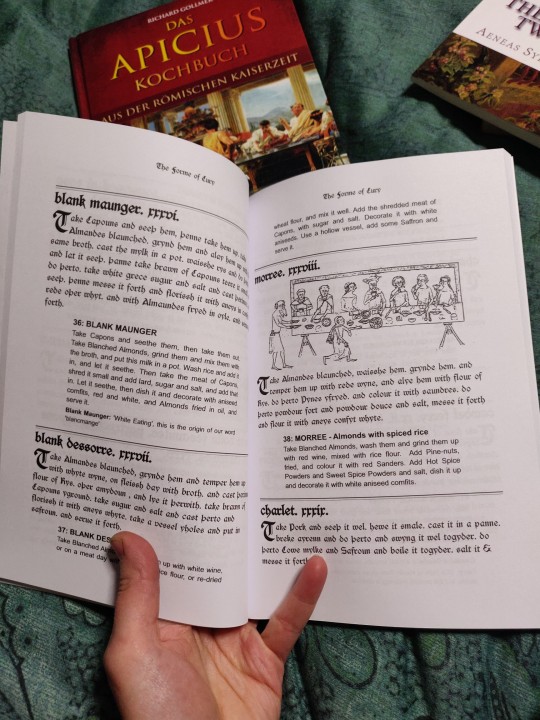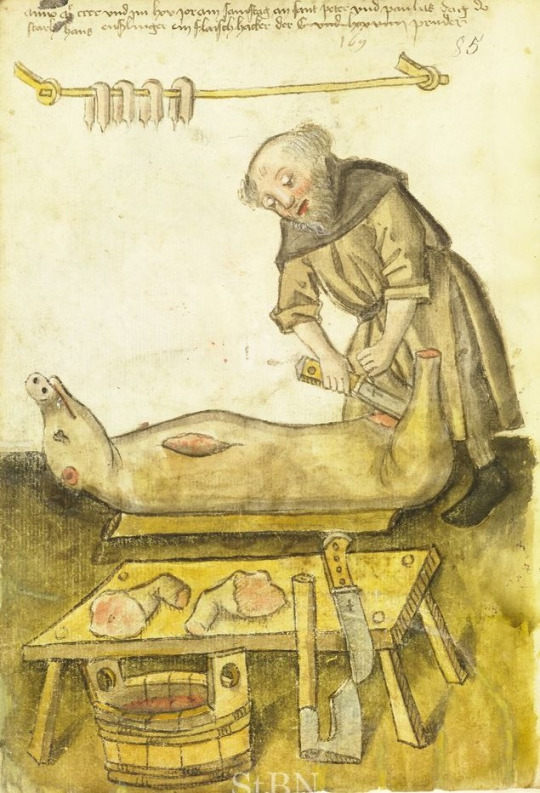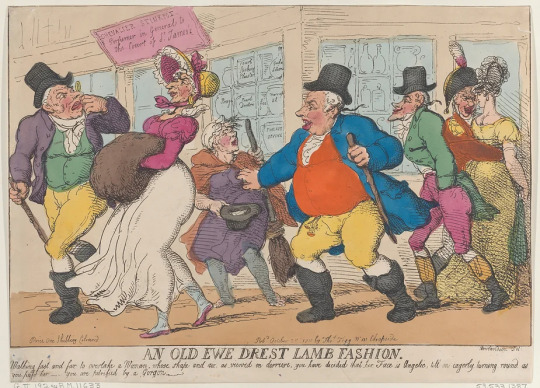Text
Harumph. Must we get involved just because the kids are squabbling? (side-eyes Atlantia) It's so undignified.
(Now if the Mid gets involved, it might be a different story...)
We got actual measurable snow here in Coastal Southeast North Carolina, which hasn't happened in over 10 years. Our parking lot got plowed, but they piled it in from the accessibility ramp for the sidewalk, so I was out there shoveling to clear it.
I was told I shovel like I'm from the North, and like I've done it before. I just laughed it off and said no, I was born and raised SENC. 😐 I didn't have the heart to say it's similar muscle strength and stamina to beating my friends with sticks and shooting them with arrows. I guess there's another benefit to heavy fighting in the SCA.
257 notes
·
View notes
Text

Watching this brewing Interkingdom Incident from the East to see what transpires...
We got actual measurable snow here in Coastal Southeast North Carolina, which hasn't happened in over 10 years. Our parking lot got plowed, but they piled it in from the accessibility ramp for the sidewalk, so I was out there shoveling to clear it.
I was told I shovel like I'm from the North, and like I've done it before. I just laughed it off and said no, I was born and raised SENC. 😐 I didn't have the heart to say it's similar muscle strength and stamina to beating my friends with sticks and shooting them with arrows. I guess there's another benefit to heavy fighting in the SCA.
257 notes
·
View notes
Text
So one candidate for what medieval European and Asian gourds were is the calabash or bottle gourd. It's better known as the mature, hard gourd that can be made into containers but the immature gourds are edible. Not common in modern western cuisine, but it was absolutely present in pre-Columbian times, is still popular in Asia and the Middle East, and present in parts of Italy. Not generally found at mainstream grocery stores in America, but I spotted them in my local Indian market under the name dudhi (Indian and Asian markets are such a good source of ingredients that Western Europe and its former colonies forgot about)
A few weeks ago, as an experiment, I turned a pair of green bottle gourds into Gourdes in Pottage as adapted from the Forme of Cury and I was completely satisfied with it as a lunchtime meal (and a few more meals afterward). The texture and flavor is much closer to summer squashes (i.e. zuchinni/courgettes) than winter squashes like butternut, so if I were looking for a substitute, I'd steer toward those. Give it a try!
(Beware other members of the gourd family if you don't know what you're looking for. At Known World Cooks and Bards last year, as the leftovers were being foisted on people as they were grabbing breakfast and packing up to leave and I had someone warn me "don't eat the snake gourd, it's awful". Well now I had to at least taste it (prepared in a Chinese manner, stir fried with, I think, soy and/or other fermented bean seasoning) and while I didn't hate it, it was decidedly bitter and definitely in the "acquired taste" category.)
Arabic Lunch, Corónú Nollaig na mBan
For Drachenwald's 12th Night Coronation, The Honourable Lords Arpad and Unegen hatched the idea of a journey on the Silk Road, starting in Italy, moving through the Middle East and Mongolia to China in different meals. My contribution to this was Saturday's lunch, as an Arabic meal.
Lunch at Coronation needs to be filling, survive being kept hot for an arbitrary length of time, and cope with a wide range of allergies, tolerances, likes and dislikes. Some of the royalty were not keen on lamb, which rather limits what can be done in medieval Arabic cuisine.
Eventually I settled on some recipes from A Treasure Trove of Benefits and Variety at the Table: A Fourteenth-Century Egyptian Cookbook (2018), translated by Nawal Nasrallah.
(49) Recipe for rummāniyya bi-dajāj (pomegranate stew with chicken)
Boil a fine plump chicken (dajāj fāʾiq) in salted water, along with galangal (khūlanjān) and cassia (dār Ṣīnī), a stick of each, until it is almost done.
When it is completely cooked, take fresh pomegranate seeds, both sweet and sour. Press them with a stone, put them in a sieve (ghirbāl) and press them down [to extract] the juice. Take half the juice and add it to the pot. Blend the second half with some [finely crushed] almonds, and add it to the pot [in the final stage] when it is simmering on the smoldering fire, to thicken the sauce. Season it with aromatic spices, rosewater, and camphor. Keep the pot on the smoldering fire to simmer, and then remove.
Modern Version: Boil chicken pieces (thigh or leg, ideally) in salted water with galangal root and a stick of cinnamon. Add pomegranate juice (which we can just buy, rather than needing to make) to the pot, and mix some more with ground almond, adding it to the pot toward the end of cooking as a thickener. Season with ground ginger, ground cloves, and ground cardamom.
Notes: I left out the camphor, since getting food-grade stuff reliably is very difficult, and it’s a more alien taste than I want to use in a main dish. Rosewater is on the do-not-serve list for some of the royalty too, so I left it out.
(101) Recipe for taqliyyat yaqṭīn (fried dish with gourd)
You need meat, gourd, garlic, black pepper, chickpeas, cilantro, and a small amount of polished rice (ruzz mubayyaḍ). Boil the meat, [drain off its broth], and fry it with garlic, black pepper, and cilantro. Return the broth to it, and let it boil on a strong fire. Throw in the gourd and rice, and if preferred, some meatballs (mudaqqaqa), and then remove.
Modern Version: Simmer stewing beef in water until it’s falling apart (needs to be started early!). When it’s cooked, drain the broth, and fry off the meat with garlic and black pepper. Put it back in the broth with chopped butternut squash pieces, chickpeas, and rice, and cook until rice is done. Remove from the pot with a slotted spoon so that broth mostly drains away, and pile on platters.
Notes: Cilantro/coriander tastes like soap to many people, so I left it out here, and served it as a garnish instead. Exactly what the medieval Arabic gourd was is a bit of a mystery; butternut squash is an easily available substitute in the right direction. Chickpeas are listed at the beginning, but not mentioned in the method, so my guess was that they go in with the other ingredients at the end. These dishes were served with plain rice and flatbreads, with chopped coriander as an optional garnish, and there was also a vegan version of the rummāniyya bi-dajāj, replacing the chicken with chickpeas and aubergine pieces.
Everything seemed to go down well, and a few people were very pleased with some of the dishes, even the somewhat invented vegan version.
8 notes
·
View notes
Text
At risk of pre-empting the author Herself, I'm going to wager that the fictional deity likely to appear in her universe would not be a god so much as a Goddess...specifically the Goddess from the Middle Kingdoms universe who can in fact appear in any gendered or not-so-gendered form She wishes and once in each person's lifetime offers herself as a lover in the form and manner of each person's preference.
So you're hanging out with your wizard friend. You're going through various planes of existence as they try to figure out how to reverse your petrification curse (it's okay, it's going slowly, right now you just have some grey stiff toes). They pull you aside and say "Alright, we gotta go through this court... I think the royal magician can help us. But be careful, there's a God here. Be respectful and obedient if they say anything"
You walk in, nervously, and it all goes to hell immediately. Your wizard buddy is spotted and you have to make introductions. Your wizard friend says "I'm pleased to introduce you to the God of Gender" and motions for you to say something.
How do you greet the God of Gender?
1K notes
·
View notes
Text
"Ah, what a beautiful yarn free day" POV: Fiber arts people walking by a craft store.
19K notes
·
View notes
Text
7K notes
·
View notes
Text
Noting for my own art reference...I've been playing with new paints.







Currently obsessed with these naturalistic illuminations from a manuscript of De Proprietatibus Rerum (1447, Bibliothèque d'Amiens, ms. 399). I just know that whoever commisioned this must have hired the nearest artist with an insane obsession for birds before proper birdwatching was even a thing. They hired the nearest De arte venandi cum avibus fanboy.



Like, the fact that despite the stylized drawings you can clearly tell that these are a corvus corax, a corvus cornix?! Hello?!?!
I love you, unknown french artist from the 15th century.
Edit: a couple people made me rightfully notice that what I thought could be a carrion crow, in absence of better candidates, could actually be a coloeus monedula, a jackdaw, and that either way it doesn't even match the text it is meant to represent as it was a total misinterpretation of it. Just to let everyone know!
Still love these paintings and these corvids.
6K notes
·
View notes
Text
Ma'rm, don't think I didn't notice the slant "I'm a doctor, not a (x)" line you snuck into the dialogue of the cyborg doctor in Starrise at Corrivale.
(Why yes, I picked up used copies of the StarDrive tie-in trillogy. I forget how I found out about them or why I was poking into the now mostly-forgotten TSR campaign setting, but they had your name on them and I hadn't heard of them before, a thing which has become vanishingly rare for me.)
THE CREW ARE SINGING A FEDERATION VERSION OF THE ORANGE AND THE GREEN ON THE RECREATION DECK. THEY HAVE APPROPRIATED SPOCK’S VULCAN SYNTHESIZER/HARP I AM FUCKING EXPIRING.
DIANE PLEASE
191 notes
·
View notes
Text
Earmarking for "I ought to look this up to get myself a copy..."
I have now received the 14th century cook book i was talking about!

tadaa! and it is so pretty on the inside


so it has the modern english translations to the original, with illustrations and stuff. it is so cute
i already talked my medieval friend into trying things out when i am back home after the holidays
54 notes
·
View notes
Text
I got a laptop with Windows 11 for an IT course so I can get certified, and doing the first time device set-up for it made me want to commit unspeakable violence
Windows 11 should not exist, no one should use it for any reason, it puts ads in the file explorer and has made it so file searches are also web searches and this cannot be turned off except through registry editing. Whoever is responsible for those decisions should be killed, full stop.
Switch to linux, it's free and it's good.
142K notes
·
View notes
Text
Love how tumblr has its own folk stories. Yeah the God of Arepo we’ve all heard the story and we all still cry about it. Yeah that one about the woman locked up for centuries finally getting free. That one about the witch who would marry anyone who could get her house key from her cat and it’s revealed she IS the cat after the narrator befriends the cat.
352K notes
·
View notes
Text








some 15th century occupations: chainmail-maker, bridle-maker, clerk, tailor, spice dealer, butcher, cutler, bird-catcher
from the "hausbuch der mendelschen zwölfbrüderstiftung", vol. 1, nuremberg (bavaria), 1426-1549
source: Nuremberg, Stadtbibliothek, Amb. 317.2°, fol. 10r, 14r, 62r, 67r, 75r, 83v, 95v, and 99r
1K notes
·
View notes
Text

"Women could be found working on construction sites, if only occasionally, including in specialized roles such as carpenters and masons. The research is found in the article, “Appropriate to Her Sex?” Women’s Participation on the Construction Site in Medieval and Early Modern Europe,” by Shelley E. Roff.
She surveyed a wide variety of records from throughout Western Europe, including tax records, inventories of wages paid on construction sites, and municipal accounts, and discovered numerous instances of women working alongside men on construction sites as far back at the 13th century. Most of these women were employed as day laborers, carrying out tasks such as moving water and building supplies around the sites, digging ditches and serving as assistants to bricklayers and stonemasons. For example, in the Spanish city of Seville during the 14th century, women were hired to dig trenches for the foundation of a new city wall, while at the nearby city of Toledo, one or two women were hired each day for the construction of the city’s cathedral, where they gathered lime and worked on the roof. Meanwhile in the French city of Toulouse, almost half the laborers working on the Perigord college site were women. Ross also finds several examples from England and Germany.
Roff notes that previous historians have seen many examples of women working on construction sites in their research, but they had believed that these were just abnormal exceptions caused by economic crises, or because the male population had been killed off through war or disease. But her new study suggests that women construction workers were more than just odd occurences. She explains that “the expansion of urban centers starting in the thirteenth century set off a trend of increasing female employment for day laborers and in the crafts, which only began to contract on occasion for women working in the crafts in the sixteenth century with ensuing economic crises.”
She also notes that in almost all accounts surveyed, the women were paid at a lower rate than the men, which would make the “a cost-effective solution” for site supervisors looking for ways to reduce expenses. The women who took these jobs would have come from society’s poor – those women who could not maintain their households and families just from their husbands’ (if they had one) income.
Roff also finds records showing women taking part in specialized building trades. In London in 1383, Katherine Lightfoot is recorded as the supplier of 2,000 painted tiles for bath in the King’s palace. Meanwhile, tax records from Paris during the years 1296 and 1313 reveal the existence of two female masons, a tiler and a plasterer. These women were not poorer individuals, rather they were the wives of male craftsman, and in some cases their widows. The 15th-century French writer Christine de Pizan noted in her book The Treasury of the City of Ladies that craftswomen, “should learn all the shop details so that she can properly supervise the workers when her husband is away or not paying attention.”
Women workers could be found on the medieval construction site, Medievalists.net
799 notes
·
View notes
Text
Achievements in remote administration of legacy systems. A perspective I understand intimately in my current day job except mine don't involve anything as high-profile and glamorous as a deep space probe.
Y'all, the world is sleeping on what NASA just pulled off with Voyager 1
The probe has been sending gibberish science data back to Earth, and scientists feared it was just the probe finally dying. You know, after working for 50 GODDAMN YEARS and LEAVING THE GODDAMN SOLAR SYSTEM and STILL CHURNING OUT GODDAMN DATA.
So they analyzed the gibberish and realized that in it was a total readout of EVERYTHING ON THE PROBE. Data, the programming, hardware specs and status, everything. They realized that one of the chips was malfunctioning.
So what do you do when your probe is 22 Billion km away and needs a fix? Why, you just REPROGRAM THAT ENTIRE GODDAMN THING. Told it to avoid the bad chip, store the data elsewhere.
Sent the new code on April 18th. Got a response on April 20th - yeah, it's so far away that it took that long just to transmit.
And the probe is working again.
From a programmer's perspective, that may be the most fucking impressive thing I have ever heard.
113K notes
·
View notes
Text

Personally, I think getting you started on medieval period food adulteration would be rather entertaining (and relevant to my interests) if you have time.
companies are delusional if they think consumers don't notice shrinkflation. less food in the package, less medicine in the jar, less whatever in the wherever, it doesn't matter where and it's almost always noticeable. like i just finished one box of medicine and we opened another allegedly identical one that we just bought and lo and behold, the four middle medicine segments were gone from the package. they took out four pills from the same sized box and sold it at the same price without any indication on the box other than the small number in the corner. ridiculous
79K notes
·
View notes
Text
I sat on low-speed rail for about three days to get from Arizona to Upstate NY. The circumstances that led to this happening were...rough...but it was the most effective way to get myself and several boxes of my stuff across the country when I didn't own a car and I got to rest and stretch my legs and lean my seat back without completely screwing over the person behind me and get up and walk more or less when I felt like it and plug my devices in to have them reliably powered and have a lot of good scenery to boot.
“Nobody’s going to want to sit on high-speed rail for fifteen hours to get from New York City to LA.”
Me. I will sit on high-speed rail for fifteen hours. I’ll sit on it for days. I’ll write and read and nap and eat and then do it all over again. I’ll stare out the windows and see America from ground level and not have to drive. I’ll see the Rockies and the deserts and cornfields and the Mississippi River and your house and yours and yours too. I’ll make up stories in my head about the small towns I see as we go along. I’ll see the states I’ve yet to see because driving or flying there is a fucking slog and expensive to boot. I’ll enjoy the ride as much as the destination. And then I’ll do it all over again to come the fuck home.
144K notes
·
View notes
Text
A small wrinkle in that reasoning as far as lamb in the US goes: Most of the lamb I see in mainstream supermarkets over here is imported, often from as far as Australia and New Zealand. (Edit to add later: And is also very expensive, and so generally a Special Occasion buy even for those of us who love it.)
It appears on restaurant menus, and in small (and somewhat seasonal) quantities in grocery stores, and it is probably traded in higher volumes in the growing number of Middle Eastern markets, but on most days in most places it's a toss up as to whether I'll even find lamb for sale to purchase. Goat only appears in specialty and ethnic markets and mutton is right out unless you have some connections.
I would posit this is less because of the abundance of factory farming here and more because, at least in the case of sheep, the utter lack of a major sheep industry here. England ruled the European wool trade for centuries but cotton (for good and for a whole lot of ill) was king in America, so what sheep production we had here (I don't have sources for this, I'm making educated guesses) was relatively small, and modernly, synthetics have crowded wool out of the market (a pity, as I have been getting into historical costuming and wool is actually awesome), and I'm not even sure sheep have been tried on a factory farming model.
Is "Uh, nope" a frequent US response to lamb?
Or is US lamb somehow different?
This is just a vaguely mystified response to some comments here.
I'm guessing the "G-word" is gamey. I've smelt gamey meat, I don't like it, and Irish lamb definitely isn't that. Also, most people I know don't need to screw up their courage before cooking or eating it.
Mutton, mature sheep-meat, has - or so I've been told, because I've never found it in any local butcher - a much fuller flavour, still not gamey, but more ... robust, pronounced, emphatic, choose your descriptor. It is, after all, a more mature meat.
For terminology reference (though this may not be current any more), "lamb" is up to one year old, "hogget" - remember the farmer's name in "Babe"? - is up to two years old, and "mutton" is over two years.
*****
As I said, I haven't seen mutton anywhere, and haven't HEARD of hogget.
This might be, as I hinted, because terminology has been simplified and all meat from sheep is now "lamb" - and that may answer my own question. Sometimes US lamb has a fuller flavour than, say, Wicklow lamb in Ireland, because sometimes US lamb is hogget or mutton instead.
If so, it restores a possible original meaning to "mutton dressed as lamb". That's now best known as "an older woman dressed inappropriately young", and though the meaning has been around for a long time (this Rowlandson print is dated 1810)...

..."dressing" is also the term for preparing meat for sale.
And THAT makes me wonder if the critical phrase goes beyond fashion into the fine old tradition of adulterating food, and wily butchers transforming elderly sheep into the semblance of younger lamb then charging undiscerning customers accordingly.
I don't know how they might have done it, but if they could then they would. The ways in which 18th-19th century foods were fiddled with is amazing, and more than a bit Yuck.
Or in this case, Ew.
Comments, corrections, criticisms and all the rest are cordially invited.
:->
*****
Side-note; in keeping with the way nicknames get attached to surnames - "Chalky" White, "Dusty" Miller etc. - anyone called Curry usually ended up as "Mutton".
Two brothers at my school had this happen; Tom Curry, the older one, had been "Mutton" for a couple of years, and when his kid brother Will started school he became, of course, "Lamb".
Oh, how we laffed...
*****
ETA: @bellyoftheblast just messaged me this:
It turns out, and I only learned this very recently (I think it's in Hannah Glasse) that "dressed" used to mean "cooked" rather than "prepared for sale". Which would mean "mutton dressed as lamb" would be fast-cooked and thus greasy, unpleasantly tough and decidedly stringy. (Meanwhile I'll never waste good lamb on stew again now that I have a source for mutton -- MUCH better flavour for slow cooking).
Thanks for this snippet! We've got the Prospect Books facsimile of Hannah Glasse 1st ed, so I pulled it down, blew off the dust - it's been a while - and yes indeed, I found the following recipes in just four successive pages:
"To dreſs a Leg of Mutton à la Royale",
"To dreſs a Leg of Mutton to eat like Veniſon",
"To dreſs Mutton the Turkiſh Way"
"To dreſs Veal à la Bourgoiſe"
Mutton dressed (or dreſsed) as Lamb doesn't get mentioned, probably because Mistress Glasse knew better, though that business of Mutton to eat (taste) like Venison is interesting.
It involves cutting the leg of mutton "in the shape of a Haunch of Veniſon" then steeping it in the sheep's blood "for five or six Hours" before wrapping it in layers of buttered paper and roasting it, basted frequently with butter or beef dripping.
Not quite mutton as lamb, but still mutton disguised as something more expensive...
1K notes
·
View notes